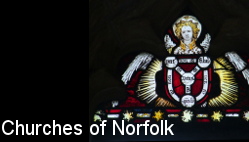
home I index I introductions I e-mail I about this site
St Andrew, Holme Hale
Follow these journeys as they happen at Last Of England Twitter.
| St
Andrew, Holme Hale This tall church sits not far from the busy Swaffham to Watton road, but it is set back down a narrow lane in what must have been the original settlement, accentuating its height. Unusually for around here the church is kept locked, and the nice man who came to open up for us seemed most surprised to hear that other churches round about were open daily. This was a Norman building of which perhaps the lower part of the tower survives, but there were busy building campaigns over the following centuries. Pevsner notes that the 'church' (which is to say the nave) was referred to as 'new' in bequests of both 1389 and 1469, and what we see today appears mostly of the later date, entirely Perpendicular in style. The building of the tower can be dated by a series of bequests over the 15th Century, although oddly on all four sides there is the high ghost of a pointed arch picked out in what appears to be brick. How strange. Is it possible that in its Norman incarnation this was a central tower with.transepts? There is no south aisle, and from this side the tall church appears austere, rising relentlessly against the tower. There is a blocked entrance beneath the tower which looks as if it might have been a processional way, although it is hard to see that one would ever have been necessary unless there were plans for further building that did not come to fruition. The north side is ameliorated by an aisle and clerestory and a curiously disproportionate porch, long and low. It's through this you step into the church. When I first came this way about twenty years ago, Holme Hale church was in the news because of its a remarkably severe bat problem. The stench of bat wee and poo was overwhelming. People from outside the UK reading this may be astounded to learn that, as bats are a protected species, not only are you forbidden from getting rid of them, it is also illegal to dissuade them from coming back. In fact, you must encourage them to stay, or else the Law will be down on you like a ton of hot bat poo, discolouring woodwork, staining brasses, and making unpleasant crunchy noises in the aisles. Well, there are still bats at Home Hale, but the parish seems to have got cleverer at dealing with them, and the interior feels well kept, a long sheet running the length of the centre to collect the bat poo, and regular cleaning, a tiresome regime but one that seemed to have them holding up their hands in despair when I was first here. The benches in the aisle date from the 1860s, but they replicate those in the north aisle that are 15th Century and of a most unusual design. The bench ends have figures on them, but instead of standing proud they are contained within alcoves, often cleverly arranged to fit in with the an elephant with a castle on its back, and a devil who appears to be preparing something for the cooking pot between his legs. There is an unpainted 15th Century screen, with elaborate wheels in the spandrels above the entrance as at Edingthorpe and Merton. The roof above appears to also be late 15th Century, with angels on the ends of the hammer beams. As Pevsner points out, the carpenter had his measurements wrong and needed a short extra bay to meet the tower. Beyond the chancel arch the carpeted chancel with its modern chairs is neat and purposeful, the crisp sedilia and piscina tidied up. There's a curious square alcove in the splay of the blocked chancel doorway, perhaps the remains of a stoup? The restrained 1890s crucifixion in the east window, presumably by Powell & Sons, is of a piece with the painted reredos on the wall below, and presumably by the same workshop. At the time of the 1851 Census of Religious Worship, incumbents had to declare which year the church was consecrated if it was after 1800. Henry Milne, rector of Holme Hale, replied that it was consecrated long before 1800, underlining the first word to emphasise it. The church had a regular attendance of a hundred for morning worship and a hundred and fifty for the afternoon sermon, which out of a parish of about five hundred people was a high proportion for Norfolk. Milne received £538 a year, well over £100,000 in today's money, so he must have been pleased with his lot. He also reported that there is a farm in the parish of about 40 acres left for keeping the parish church in repair (i.e. from the rent) and for other like charges. However, about twenty years earlier a new Primitive Methodist chapel had been established in the village which was already attracting almost as many to morning worship. This was the landscape on which a battle of ideas would play out over the rest of the century. Simon Knott, October 2022 Follow these journeys as they happen at Last Of England Twitter. |
|
|||||||||||||||||||||||||||||||||||||||||||||||||||||||
home I index I latest I introductions I e-mail I about
this site I glossary
Norwich I ruined churches I desktop backgrounds I round tower churches
links I small
print I www.simonknott.co.uk I www.suffolkchurches.co.uk